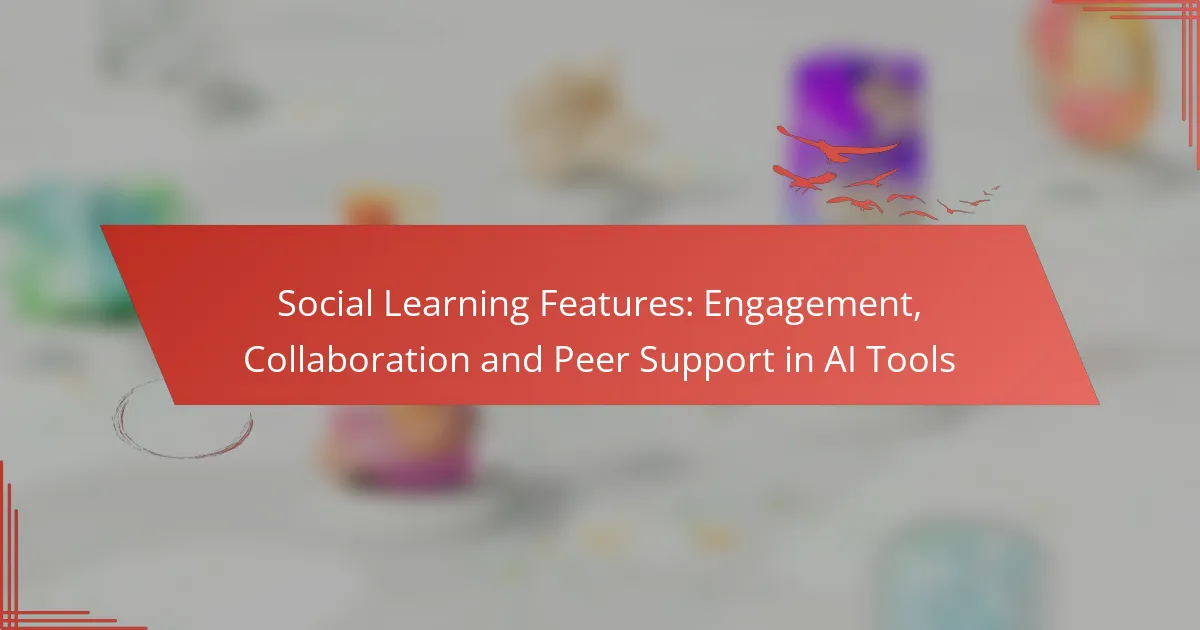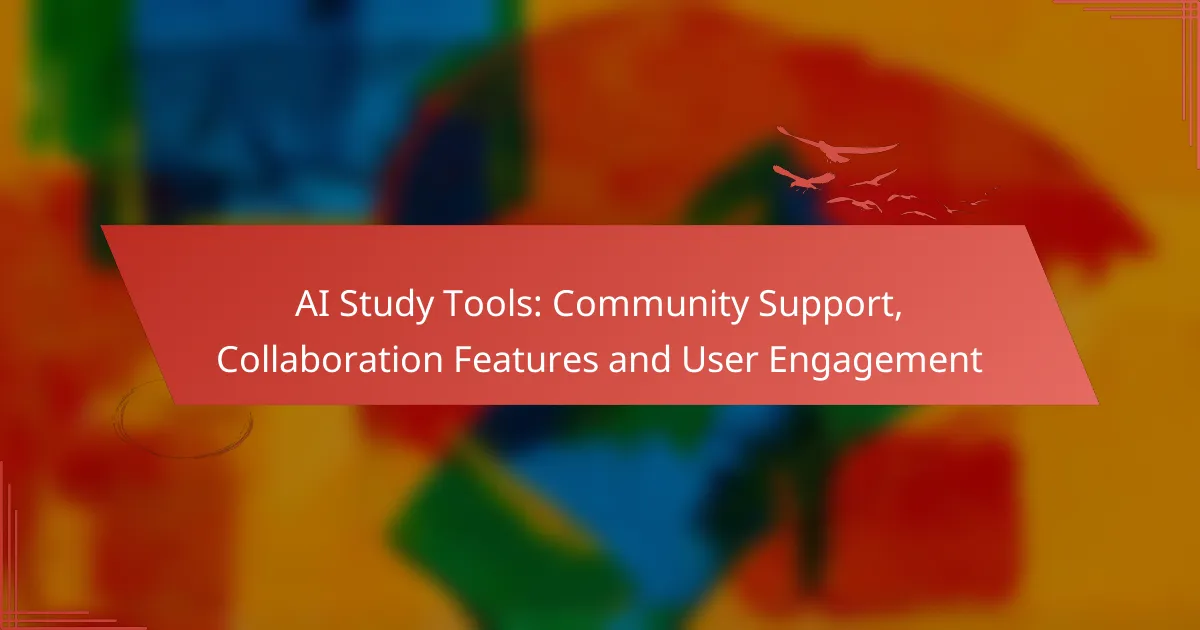AI tools play a crucial role in enhancing social learning by fostering engagement, collaboration, and peer support among learners. By providing interactive and personalized experiences, these tools motivate users and facilitate teamwork, resource sharing, and effective communication. This collaborative environment not only enriches the learning experience but also encourages a supportive community that leads to improved outcomes.

How Do AI Tools Enhance Engagement in Social Learning?
AI tools enhance engagement in social learning by providing interactive and personalized experiences that motivate learners. These tools leverage technology to foster collaboration and peer support, making the learning process more dynamic and effective.
Interactive content features
Interactive content features, such as quizzes, simulations, and discussion forums, actively involve learners in the educational process. By allowing users to engage with material rather than passively consume it, these features promote deeper understanding and retention of information.
For instance, an AI-driven platform might include scenario-based learning modules where users make decisions and see the outcomes, enhancing critical thinking and application of knowledge. This hands-on approach can significantly increase learner engagement and satisfaction.
Gamification elements
Gamification elements, like points, badges, and leaderboards, introduce a competitive aspect to social learning. These features motivate learners to participate more actively by rewarding achievements and progress, making the learning experience more enjoyable.
For example, a platform might allow users to earn points for completing tasks or collaborating with peers, which can be displayed on a leaderboard. This not only encourages participation but also fosters a sense of community among learners.
Real-time feedback mechanisms
Real-time feedback mechanisms provide immediate responses to learners’ actions, helping them understand their progress and areas for improvement. This instant feedback can significantly enhance engagement by allowing learners to adjust their strategies promptly.
AI tools can analyze user performance and offer tailored suggestions or corrections, ensuring that learners stay on track. For instance, if a user struggles with a particular concept, the system might provide additional resources or alternative explanations to reinforce understanding.
Personalized learning paths
Personalized learning paths adapt to individual learners’ needs and preferences, making the educational experience more relevant and engaging. By analyzing user data, AI tools can recommend specific content and activities that align with each learner’s goals and learning style.
For example, a learner interested in a specific topic might receive tailored resources and exercises that focus on that area, while others may follow a more general curriculum. This customization not only boosts engagement but also improves overall learning outcomes by addressing unique learner needs.

What Collaboration Features Are Essential in AI Learning Tools?
Essential collaboration features in AI learning tools facilitate teamwork, resource sharing, and effective communication among users. These functionalities enhance the learning experience by promoting engagement and peer support.
Group project functionalities
Group project functionalities allow users to collaborate on assignments and tasks in real-time. These features typically include shared workspaces, task assignments, and progress tracking, which help keep team members aligned and accountable.
For effective group projects, consider tools that offer version control and feedback mechanisms. This ensures that all contributions are recognized and that the project evolves through collaborative input.
Shared resources and materials
Shared resources and materials enable users to access and contribute educational content, such as articles, videos, and documents. This feature fosters a collaborative learning environment where participants can build a collective knowledge base.
When selecting an AI tool, look for options that support easy uploading and categorization of materials. This makes it simpler for users to find relevant resources and enhances the overall learning experience.
Integrated communication channels
Integrated communication channels facilitate seamless interaction among users, allowing for discussions, feedback, and brainstorming. These channels can include chat functions, discussion boards, or video conferencing tools, making collaboration more dynamic.
Choose tools that offer multiple communication options to cater to different preferences. For instance, some users may prefer instant messaging for quick questions, while others may benefit from video calls for in-depth discussions.

How Does Peer Support Function in AI Learning Environments?
Peer support in AI learning environments enhances collaboration and engagement among learners by facilitating shared experiences and knowledge exchange. This support system encourages users to assist one another, fostering a community that can lead to improved learning outcomes.
Peer mentoring systems
Peer mentoring systems connect learners with more experienced peers who can provide guidance and support. These relationships often involve regular check-ins and goal-setting, which can help mentees stay motivated and accountable. For instance, a student struggling with a specific AI tool might benefit from a mentor who has successfully navigated similar challenges.
To implement an effective peer mentoring system, institutions should consider pairing individuals based on their skills and learning objectives. Regular feedback and structured sessions can enhance the mentoring experience, ensuring that both mentors and mentees gain value from the relationship.
Discussion forums and communities
Discussion forums and online communities serve as platforms for learners to share insights, ask questions, and collaborate on projects. These spaces can range from formal platforms hosted by educational institutions to informal groups on social media. Engaging in these forums allows users to tap into a diverse pool of knowledge and perspectives.
To maximize the benefits of discussion forums, participants should actively contribute by asking questions and sharing their experiences. Establishing clear guidelines for respectful communication can help maintain a positive environment, encouraging more users to participate and share their expertise.
Feedback and review systems
Feedback and review systems enable learners to receive constructive criticism on their work from peers, which can enhance their understanding and skills. These systems often involve structured peer reviews where participants assess each other’s projects or assignments based on predefined criteria. This process not only helps the recipient improve but also reinforces the reviewer’s knowledge.
When setting up feedback systems, it’s crucial to provide clear rubrics and guidelines to ensure that reviews are constructive and focused. Encouraging a culture of positivity and growth can help alleviate the anxiety often associated with peer feedback, making it a more beneficial experience for all involved.

What Criteria Should You Consider When Choosing AI Learning Tools?
When selecting AI learning tools, focus on user interface, integration capabilities, and cost structures. These factors significantly impact user engagement, collaboration, and overall effectiveness of the tools in a learning environment.
User interface and experience
A user-friendly interface is crucial for maximizing engagement with AI learning tools. Look for platforms that offer intuitive navigation, clear layouts, and responsive design to enhance the learning experience. Tools that prioritize user experience often lead to higher satisfaction and better collaboration among peers.
Consider features such as customizable dashboards, accessibility options, and mobile compatibility. A well-designed interface can reduce the learning curve and encourage more frequent use of the tool.
Integration with existing platforms
Effective AI learning tools should seamlessly integrate with your current systems, such as Learning Management Systems (LMS) or collaboration platforms. This compatibility allows for smoother data sharing and enhances the overall learning experience.
Check for APIs and available plugins that facilitate integration. Tools that can easily connect with platforms like Google Workspace or Microsoft Teams can streamline workflows and promote collaborative learning.
Cost and subscription models
Evaluate the cost and subscription models of AI learning tools to ensure they fit within your budget. Many tools offer tiered pricing based on features, user numbers, or usage levels, so consider what you need most before committing.
Look for options that provide free trials or money-back guarantees, allowing you to test the tool before making a financial commitment. Additionally, be aware of any hidden fees or costs associated with upgrades or additional features.

What Are the Benefits of Subscription-Based AI Learning Tools?
Subscription-based AI learning tools offer users access to enhanced features, ongoing updates, and a supportive community. These benefits can significantly improve the learning experience by providing valuable resources and fostering collaboration among users.
Access to premium features
Subscription plans often unlock advanced functionalities that are not available in free versions. These premium features may include personalized learning paths, in-depth analytics, and exclusive content tailored to user needs.
For example, a subscription might provide access to specialized courses or tools that facilitate real-time feedback, enhancing the learning process. Users should evaluate which premium features align with their learning goals to maximize their investment.
Continuous updates and improvements
With a subscription, users benefit from regular updates that enhance the tool’s capabilities and user experience. These updates can include new content, improved algorithms, and bug fixes that ensure the tool remains effective and relevant.
Staying current with the latest advancements in AI learning technology can significantly impact the quality of education received. Users should look for platforms that communicate their update schedules clearly and demonstrate a commitment to ongoing improvement.
Community support and networking
Subscription-based AI learning tools often come with access to vibrant user communities. These communities provide opportunities for networking, collaboration, and peer support, which can enhance the overall learning experience.
Engaging with fellow learners can lead to sharing insights, resources, and best practices. Users should actively participate in forums or group discussions to leverage the collective knowledge and support available within the community.



